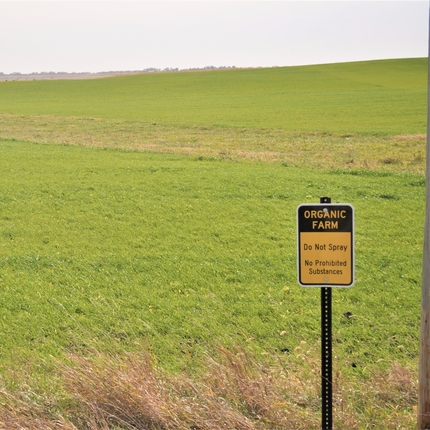This story was written by Matthew Fitzgerald in May 2023. Matthew is an organic farmer in Glencoe, Minnesota. He operates Fitzgerald Organics, LLC and has been producing diversified organic crops for more than 20 years with his family.
In Minnesota and our neighboring states, planting season is upon us. Whether you are a farmer, live in a rural area, or are otherwise connected to the industry, this time of year is exciting. Yet, organic farmers like me are burdened by dates set by the U.S. Department of Agriculture (USDA) as we make our planting decisions each spring.
The first farmers you will see out in the fields, planting crops like corn and later soybeans, are not organic farmers. They are farmers growing their crops using conventional methods. Organic farmers have to plant their crops later than our conventional neighbors—corn typically two to three weeks later.
One reason is that we have to wait for the soil temperature to reach a sustained temperature of 50 degrees Fahrenheit. Corn seed that sits in cool, moist ground for too long is vulnerable to seed rot and other issues. As organic farmers, we must be attentive to this, as we do not have the same seed coatings or technology that our conventional neighbors can rely on. We also delay planting, waiting for an early “weed flush” of germinating weeds to manage before planting. In an organic system, we do not have as many weed management tools available to us, compared to our conventional neighbors who can spray herbicides, hence we wait for nature to tell us when to plant.
Another reason we plant later is to avoid pollen contamination. To maintain the integrity of our official organic certification, we must avoid cross contamination with conventional GMO corn. Waiting two weeks after the neighbor has planted offsets the pollination window of our corn that occurs later in the summer. Losing this certification would put my operation at risk, and threaten my ability to sell my crops.
As we begin to plant, a final planting date set by the USDA’s Risk Management Agency (RMA) will be at the top of our mind. The vast majority of row crop producers in Minnesota insure their crops using federal crop insurance, to protect them in case of a loss or disaster. Our crops must be in the ground by the final planting date, or we will be penalized with a 1% reduction in coverage for each day that follows.
In my county, the final planting date for corn is May 31. We hope to be done planting by then, but, depending on the conditions each year, it is not uncommon for me to plant my corn later. Some years, this has made a considerable impact on our operation.
I have only had to rely on crop insurance when I’ve experienced significant loss or damage. In the case of a delayed planting, the lost coverage from missing the final planting date makes a bad situation worse. Crop losses are stressful on any operation; the losses are exacerbated when the crop insurance that is intended to manage our risk is driven by the calendar, rather than the weather.
I know I am not alone. Organic farmers in Minnesota and across our region are burdened by this date more than most. Sometimes it also impacts other crops, such as soybeans and small grains. Ultimately, holding conventional and organic farmers to the same final planting date does not make sense based on how we run our operations.
As organic farmers, we take great care in tending our land and producing healthy crops. We deserve the same quality of crop insurance as conventional farmers. RMA can make that happen by setting a planting date for organic farmers. I encourage the agency to take a look at this issue to ensure organic farmers are being treated fairly.





